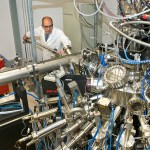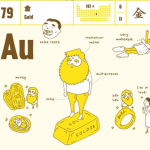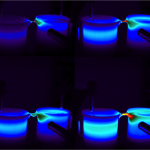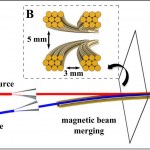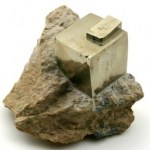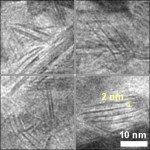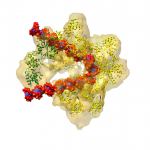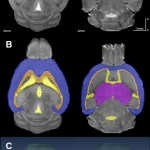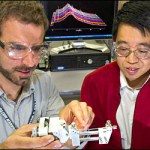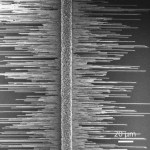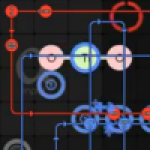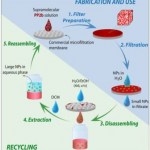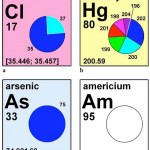Chemistry
See the way those smooth, amorphous blobs rapidly transform into textured honeycombs? Something similar is probably happening right now inside your laptop or smartphone’s battery, providing you with portable power.
But the cherished efficiency and portability of those compact lithium-ion batteries comes with a cost: each cycle of discharge/recharge degrades the material’s essential structure and ultimate longevity - you’ve probably noticed that your older electronics just don’t hold a charge like they used to. Preventing this persistent degradation requires insight into a process that plays…
High-temperature superconductors (HTS), capable of storing and transmitting electricity with perfect efficiency, are a theoretical stumbling block. The mechanism underlying HTS behavior is a mystery, and the subject of significant contention and investigation among scientists. This puzzle, unlike headline-making unknowns such as dark energy (admittedly awesome and worth losing sleep over), could revolutionize our entire energy infrastructure. But before HTS materials can flood the electricity market, they need to work their magic closer to room temperature (high-temperature is a bit…
Have ever really thought about the elements? Have you ever really asked questions about them? If you are some kind of scientist or science geek, you probably know a lot about them, and that could even be a disadvantage for you, in a sense. For instance, if you learned early on that elements were formed at certain points in time and in certain places (the big bang or later in stars, for most atoms) then the following question may not have occurred to you: "What happens when a bunch of Carbon atoms get old. Do they fall apart?" Also, a sense of purity may be something you understand but…
The term “floating water bridge” may sound nonsensical, but it’s the most logical name for a phenomenon that occurs when two beakers of water set slightly apart are zapped with high-voltage electricity and the water molecules jump across the gap to connect and form a thin thread of water. The molecular structure that suspends this liquid bridge has stumped scientists for over a century.
Now, a team of scientists has peered into floating water bridges with high-energy x-rays using the Advanced Photon Source (APS) at Argonne National Laboratory. Their work, “Floating water bridges and…
Today’s post is about some cool chemistry – very cool. About 0.01°Kelvin, as a matter of fact (that is, one hundredth of a degree above absolute zero). Physics experiments conducted at such temperatures are already old hat, but chemistry is another story, altogether. Scientists have been attempting to produce chemical reactions at ultra-low temperatures for at least 50 years; a Weizmann research team has finally achieved that goal.
Why try to get reactions to take place in these conditions, which are wholly unfavorable to the usual lab-type chemistry? The answer is that when temperatures drop…
You’ve heard of the carbon cycle, maybe even the nitrogen cycle. But have you given much thought lately to the sulfur cycle? New research in last week’s Science suggests that we should be paying a bit more attention to the way this element moves through the atmosphere, biosphere, oceans and land. Over the last 500 million years, sulfur seems to have played a fairly crucial role in keeping the oxygen levels in the atmosphere at a nice, breathable 20%.
It is microbes and weather that do the work. Microorganisms in the ocean take in sulfur in the form of dissolved sulfate – that is, in a sulfur…
With nanotechnology rapidly advancing, the sci-fi dream of a Star Trek replicator becomes increasingly less fantastic. But such radical technology would, in theory, require the kind of subatomic manipulation that far exceeds current capabilities. Scientists lack both the equipment and the fundamental knowledge of quantum mechanics (the Standard Model, for all its elegance, remains incomplete) to build items from the raw stuff of quarks, gluons, and electrons . . . but what about alchemy?
Even Isaac Newton, credited with the dawn of the Age of Reason, felt the mystical draw of alchemy,…
There are many complex steps to the dance of DNA replication. And scientists must learn to sway along in order to understand how both healthy and cancerous cells divide.
Scientists at Brookhaven National Laboratory have begun to learn how to follow the complex molecular choreography by which intricate cellular proteins recognize and bind to DNA to start the replication process.
The replication process starts off the same way in every cell. In the cell's DNA, there are defined sites called the "origin of replication." The cell in which the DNA is housed uses a protein called the "origin…
No one credits heavy drinking with making people smarter - the mind-numbing effects are well documented. Odds are that if you haven't experienced this personally, you've witnessed it in the foolish antics of others. The clear correlation between rapidly diminishing intelligence and rising alcohol consumption is no secret.
But the long-term effects may go deeper than a morning headache or a need to wear sunglasses inside. A new study conducted at Brookhaven National Laboratory reveals that genetic factors can make some individuals more susceptible than others to lasting neurological damage…
Toward the end of last year, being in possession of two novelties - a girlfriend and a steady job - I decided to spend my free evenings crafting a very special piece of jewellery. I was inspired by a visit to Barometer World in the late summer, where I discovered the curious material known as storm glass (tragic backstory recounted here).
In short, a storm glass is a weather divination tool so old that nobody really knows where they came from. It's likely they were borne out of alchemy experiments performed during the medieval period. Inside a sealed glass tube, crystals bloom, wither and…
If you followed this year's chemistry Nobel, you know about the quasicrystal design on the ties made for Prof. Dan Schechtman's 70th birthday. Even the prime minister was seen sporting one last week. But did you know there is also a quasicrystal scarf?
While Prof. Schechtman was getting his white tie and tails ready for the formal ceremony, this scarf was on display in fashionable Tel Aviv around the shoulders of Prof. Gitti Frey, a nanoscientist at the Technion.
Despite the photo op, fashion took a back seat to science last Thursday evening. Frey was the guest speaker at a Science on Tap…
Last week I had a visit from a friend of mine, who was on something of a farewell tour. After several years of planning, he'd packed in his dependable but much-begrudged corporate job, and was setting sail for Asia, to see more of the world. He's already seen much more of the world than most people. Not because he was well connected or rich, but because he made it his life's mission to tour the forgotten, the hidden and the forbidden places of the world. I mention this because if there ever was a man to take life advice from, it is this one, and he put into words something I've been…
Jason Graetz, left, and Jiajun Chen at NSLS beamline X14A with their transparent reactor for viewing chemistry in real time.
Here's a recipe for basic chemistry: Mix a bunch of stuff in a reaction vessel and see what happens. Only you don't really see the action taking place -- unless you have some way to visualize the molecular magic.
Researchers at Brookhaven National Laboratory have developed just such a technique: They've fabricated a transparent chemical reactor vessel that allows x-rays to pass through and capture the chemical changes as they take place.
They recently used this…
Earlier this month, NASA announced the discovery of DNA components in a meteorite. On We Beasties, Heather Olins writes that "while claims of meteorites containing DNA components have been made before, they may very well have been terrestrial contamination. This seems to be different, because the meteorite also contains similar molecules that are never found in biological matter." Specifically, the meteorite contains the nucleobase analogues purine, 2,6-diaminopurine, and 6,8-diaminopurine, leading Claire L. Evans to revisit the ancient concept of panspermia on Universe. Panspermia holds…
A recent study by Prof. Ernesto Joselevich and his team, published in Science, features perfectly aligned horizontal arrays of thin, millimeter-long nanowires. We spoke with Joselevich recently to find out why he and others in the field are excited by this advance:
WSW: Your lab has produced a fair amount of innovative research in recent years. Why is this one special?
EJ: First of all, we succeeded in growing very long horizontal nanowires with exquisite control over their orientation. Because of the numerous potential uses for semiconductor nanowires, there is a lot of competition to…
It's been a while since we had some Friday Flash Fun here at SciencePunk, but this one really blew me out of the water.
SpaceChem is currently causing quite a stir amongst the gaming websites: Escapist Magazine gave it the Genre Buster award and Rock Paper Shotgun hailed it as "one of the year's best indie games". Deservedly so, in my opinion.
SpaceChem puts you in the shoes of a junior materials chemist, blasted into the depths of space to work for a pan-galactic mining corporation. Your job is to build complex molecules from the basic chemicals mined out of these planets. At your…
Two completely unrelated papers have got us thinking about chemical bonds. When we refer to chemical bonds, we generally mean covalent bonds: Atoms become "wedded," sharing electrons, and breaking them apart takes energy. By comparison, other types of bonds are weak attractions - mere flirtations, or mild sparks between hydrogen and oxygen in passing water molecules.
So why would a researcher in organic chemistry - a field based on carbon, the king of covalent bonds - be investigating the properties of non-covalent, hydrophobic bonds? The answer, of course, is that they can be used to create…
This guest post is written by Norman Holden, a Brookhaven scientist in the National Nuclear Data Center and a member of the International Union of Pure and Applied Chemistry (IUPAC). After receiving his Ph.D. in nuclear physics from the Catholic University of America, he spent a decade at the GE Knolls Atomic Power Lab before joining Brookhaven in 1974. He is the chair of an IUPAC subgroup that is producing a periodic table meant to show high school and college students the importance of isotopes in everyday life.
Norman Holden
When the clock struck midnight on Saturday morning, we rang…
Here's another article we came across while editing material on the still-theoretical new website. Unfortunately, the article is more about the photographer than Anna Weizmann, herself.
Prof. Anna Weizmann was Chaim's younger sister, (there were a dozen brothers and sisters, all of them chemists, engineers and doctors). She was also one of the original 11 scientists (3 of whom were women) at what was then the Daniel Sieff Research Institute (est. 1934). She never married, (one article she co-authored referred to her as Miss Anna Weizmann) and she ran Dr. Chaim Weizmann's lab after his…
It's that time of year again-- the Swedes will be handing out money to famous scientists, with the announcements of who's getting what starting one week from today. Thus, the traditional Uncertain Principles Nobel Prize Picking Contest:
Leave a comment on this post predicting the winner(s) of one of this year's Nobel Prizes. Anyone who correctly picks both the field and the laureate will win a guest-post spot on this blog.
The usual terms and conditions apply. If you don't have anything you'd like to guest-post about, you can exchange your guest post for a signed copy of How to Teach Physics…
